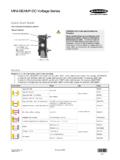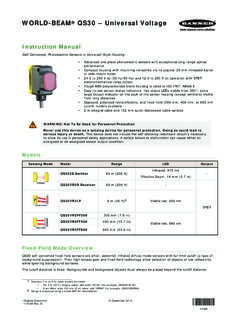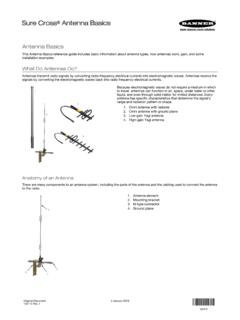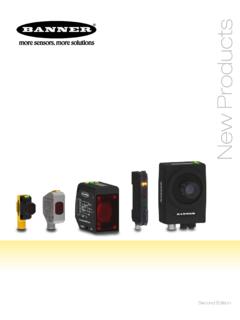Transcription of ES-FA-9AA and ES-FA-11AA E-Stop Safety Module
1 Instruction Manual Monitors emergency stop devices, such as palm buttons and rope/cable pulls, andpositive-opening Safety switches used for guard/gate interlocking The Safety inputs can monitor: A +24 V DC source switched by hard/relay contacts in single-channelhookup, or Hard/relay contacts in a dual-channel hookup using terminals S11-S12 andS21-S22 The ES-FA-9AA has three normally open output switching channels for connectionto control -reliable power interrupt circuits The ES-FA-11AA has two normally open output switching channels for connectionto control -reliable power interrupt circuits and one normally closed auxiliary outputchannel Automatic reset or monitored manual reset Design complies with standards ANSI , UL991, ISO 13850 (EN418), and ISO13849-1 (EN954-1) ( Safety Category 4)
2 For use in functional stop category 0 applications per NFPA 79 and IEC/EN60204-1 6 or 7 amp Safety output contacts, depending on model Plug-in terminal blocks 24 V AC/DC operationWARNING: Not a stand-alone safeguarding device Failure to properly safeguard hazards according to a risk assessment, local regulations, and applicablestandards might lead to serious injury or death. This Banner Engineering Corp. device is considered complementary equipment that is used to augmentsafeguarding that limits or eliminates an individual's exposure to a hazard without action by theindividual or VoltageOutputsOutput Contact RatingES-FA-9AA24 V AC/DC3 Normally Open (NO)6 AES-FA-11AA2 Normally Open and 1 Normally Closed (NC)7 AImportant: Read this FirstThe user is responsible for satisfying all local, state, and national laws, rules, codes, and regulations relating to the use of thisproduct and its application.
3 Banner Engineering Corp. has made every effort to provide complete application, installation, operation,and maintenance instructions. Please contact a Banner Applications Engineer with any questions regarding this user is responsible for making sure that all machine operators, maintenance personnel, electricians, and supervisors arethoroughly familiar with and understand all instructions regarding the installation, maintenance, and use of this product, and with themachinery it controls. The user and any personnel involved with the installation and use of this product must be thoroughly familiarwith all applicable standards, some of which are listed within the specifications. Banner Engineering Corp. makes no claim regardinga specific recommendation of any organization, the accuracy or effectiveness of any information provided, or the appropriateness ofthe provided information for a specific StandardsANSI B11 Standards for Machine Tools SafetyContact: Safety Director, AMT The Association for Manufacturing Technology, 7901 Jones Branch Drive, Suite 900, McLean, VA22102-4206 USA, 79 Electrical Standard for Industrial MachineryContact: National Fire Protection Association, 1 Batterymarch Park, Quincy, MA 02169-7471 USA, Safety Requirements for Industrial Robots and Robot SystemsContact: Robotic Industries Association, 900 Victors Way, Suite 140, Ann Arbor, MI 48108 USA, and ES-FA-11AA E-Stop SafetyModule Original Document60606 Rev.
4 I19 January 202260606 Applicable International StandardsEN ISO 12100 Safety of Machinery Basic Concepts, General Principles for DesignEN ISO 13849-1 Safety -Related Parts of control SystemsISO 13850 (EN 418) Emergency Stop Devices, Functional Aspects Principles for DesignEN 60204-1 Electrical Equipment of Machines Part 1: General RequirementsContact: IHS Markit (Global Engineering Documents), 15 Inverness Way East, Englewood, CO 80112 USA, Emergency Stop Safety Module is used to increase the control reliability of anemergency stop circuit. As shown in the wiring diagrams , the models ES-FA-9AA andES-FA-11AA E-Stop Safety Modules are designed to monitor a 1-channel or 2-channelE-stop switch. A 2-channel E-Stop switch has two electrically isolated : Ensure the Safety circuit integrity The Safety circuit integrity level is affected by the designand installation of the Safety devices and the means ofinterfacing with those devices.
5 Perform a risk assessment to determine the appropriatesafety circuit integrity level or category to ensure theexpected risk reduction is achieved and all applicableregulations and standards are in compliance (see and ANSI , ISO 12100 and ISO13849-1 orthe applicable standards).Figure 1. Features and TerminalsES-FA-9 AAES-FA-11 AAPower ON LEDC hannel 1 Active LEDC hannel 2 Active LEDS afety Circuit Integrity and EN ISO 13849-1 Safety Circuit PrinciplesSafety circuits involve the Safety -related functions of a machine that minimize the level of risk of harm. These Safety -related functionscan prevent initiation, or they can stop or remove a hazard. The failure of a Safety -related function or its associated Safety circuitusually results in an increased risk of integrity of a Safety circuit depends on several factors, including fault tolerance, risk reduction, reliable and well-triedcomponents, well-tried Safety principles, and other design on the level of risk associated with the machine or its operation, an appropriate level of Safety circuit integrity(performance) must be incorporated into its design.
6 Standards that detail Safety performance levels include ANSI Criteria for Safeguarding and EN ISO 13849-1 Safety -Related Parts of a control Circuit Integrity LevelsSafety circuits in International and European standards have been segmented into categories, depending on their ability to maintaintheir integrity in the event of a failure. The most recognized standard that details Safety circuit integrity levels is EN ISO 13849-1,which establishes five levels: Categories B, 1, 2, 3, and the most stringent, Category the United States, the typical level of Safety circuit integrity has been called control reliability. control reliability typicallyincorporates redundant control and self-checking circuitry and has been loosely equated to EN ISO 13849-1 Categories 3 and 4 (seeCSA Z432 and ANSI ).
7 If the requirements described by EN ISO 13849-1 are to be implemented, a risk assessment must first be performed to determinethe appropriate category, in order to ensure that the expected risk reduction is achieved. This risk assessment must also take intoaccount national regulations, such as control reliability or European C level standards, to ensure that the minimum level ofperformance that has been mandated is complied ExclusionAn important concept within the category requirements of EN ISO 13849-1 is the probability of the occurrence of the failure, whichcan be decreased using the "fault exclusion" method. This method assumes that the possibility of certain well-defined failure(s) canbe reduced to a point where the resulting fault(s) can be exclusion is a tool a designer can use during the development of the Safety -related part of the control system and the riskassessment process.
8 It allows the designer to eliminate the possibility of various failures and justify it through the risk assessmentprocess to meet the requirements of Categories 2, 3, or 4. See EN ISO 13849-1/-2 for further of Safety DevicesRequirements vary widely for the level of control reliability or Safety category per ISO 13849-1 (EN954-1) in Safety Banner Engineering always recommends the highest level of Safety in any application, it is the responsibility of the user tosafely install, operate and maintain each Safety system and comply with all relevant laws and regulations. ES-FA-9AA and ES-FA-11AA E-Stop Safety - Tel: + 1 888 373 6767P/N 60606 Rev. IAlthough only two applications are listed, the Module can monitor a variety of devices as long as the input requirements arecomplied with (see Electrical Installation and Specifications).
9 The Safety Module does not have 500 ms simultaneity between inputsand thus cannot be used for monitoring a two-hand control . In all cases, the Safety performance (integrity) must reduce the risk fromidentified hazards as determined by the machine's risk : Do not mute or bypass any emergency stop device Muting or bypassing the Safety outputs renders the emergency stop function ineffective. ANSI , NFPA 79 and IEC/EN 60204-1 require that the emergency stop function remains active atall Stop Push Buttons and Rope/Cable Pull SwitchesThe Safety inputs can be interfaced with positive-opening switches to monitor an emergency-stop ( E-Stop ) push button or rope/cablepull. The switch must provide one or two contacts for Safety which are closed when the switch is armed.
10 Once activated, the E-stopswitch must open all its Safety -rated contacts, and must require a deliberate action (such as twisting, pulling, or unlocking) to returnto the closed-contact, armed position. The switch must be a "positive-opening" (or direct-opening) type, as described by NFPA 79, ANSI ,, IEC/EN60204-1, and ISO 13850 specify additional emergency stop switch device requirements,including the following: Emergency-stop push buttons shall be located at each operator control station and at other operating stations whereemergency shutdown is required. Stop and emergency-stop push buttons shall be continuously operable and readily accessible from all control and operatingstations where located. Do not mute or bypass E-Stop buttons or rope/cable pulls.










